Convair B-58 Hustler Video -
|
Loading...
|
|
Low level high speed tests
Convair B-58 Hustler

Picture - B-58A in flight, June 1967
Role: Strategic bomber
Manufacturer: Convair
First flight: 11 November 1956
Introduced: 15 March 1960
Retired: 31 January 1970
Primary user: United States Air Force
Number built: 116
Unit cost: US$12.44 million
The Convair B-58 Hustler was the first operational supersonic jet bomber, and the first capable of Mach 2 flight. The aircraft was developed for the United States Air Force for service in the Strategic Air Command (SAC) during the 1960s. Originally intended to fly at high altitudes and speeds to avoid Soviet fighters, the introduction of highly accurate Soviet surface-to-air missiles forced the B-58 into a low-level penetration role that severely limited its range and strategic value. This led to a brief operational career between 1960 and 1969. Its specialized role was succeeded by other American supersonic bombers, such as the FB-111A and the later B-1B Lancer.
The B-58 received a great deal of notoriety due to its sonic boom, which was often heard by the public as it passed overhead in supersonic flight.
Design and development
The genesis of the B-58 program came in February 1949, when a Generalized Bomber Study (GEBO II) had been issued by the Air Research and Development Command (ARDC) at Wright-Patterson AFB, Ohio. A number of contractors submitted bids including Boeing, Convair, Curtiss, Douglas, Martin and North American Aviation.
Building on Convair's experience of earlier delta-wing fighters, beginning with the XF-92A, a series of GEBO II designs were developed, initially studying swept and semi-delta configurations, but settling on the delta wing planform. The final Convair proposal, coded FZP-110, was a radical two-place, delta wing bomber design powered by General Electric J53 engines. The performance estimates included a 1,000 mph (1,600 km/h; 870 kt) speed and a 3,000 statute mile (4,800 km; 2,600 nmi) range.

Picture - RB-58A with two component pod (TCP)
The USAF chose Boeing (MX-1712) and Convair to proceed to a Phase 1 study. The Convair MX-1626 evolved further into a more refined proposal redesignated the MX-1964. In December 1952, the Air Force selected the MX-1964 as the winner of the design competition to meet the newly proposed SAB-51 (Supersonic Aircraft Bomber) and SAR-51 (Supersonic Aircraft Reconnaissance), the first General Operational Requirement (GOR) worldwide for supersonic bombers. In February 1953, the Air Force issued a contract for development of Convair's design.
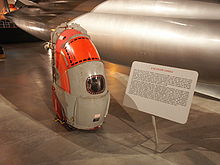
Picture - B-58 crewmember escape capsule
The resulting B-58 design was the first "true" USAF supersonic bomber program. The Convair design was based on a delta wing with a leading-edge sweep of 60° with four General Electric J79-GE-1 turbojet engines, capable of flying at twice the speed of sound. Although its large wing made for relatively low wing loading, it proved to be surprisingly well suited for low-altitude, high-speed flight. It seated three (pilot, bombardier/navigator, and defensive systems operator) in separated tandem cockpits. Later versions gave each crew member a novel ejection capsule that made it possible to eject at an altitude of 70,000 ft (21,000 m) at speeds up to Mach 2 (1,320 mph/2,450 km/h). Unlike standard ejection seats of the period, a protective clamshell would enclose the seat and the control stick with an attached oxygen bottle. In an unusual test program, live bears and chimpanzees were successfully used to test the ejection system. The XB-70 would use a similar system.
Because of heat generated at Mach 2 cruise, not only the crew compartment, but the wheel wells and electronics bay were pressurized and air conditioned. The B-58 utilized one of the first extensive applications of aluminum honeycomb panels, which bonded outer and inner aluminum skins to a honeycomb of aluminum and fiberglass.
The pilot's cockpit was fairly conventional for a large multiengine aircraft. The electronic controls were ambitious and advanced for the day. The navigator and DSO's cockpits featured wrap around dashboards with warning lights and buttons, and automatic voice messages and warnings from a tape system were audible through the helmet sets. Research during the era of all-male combat aircraft assignments revealed that a woman's voice was more likely to gain the attention of young men in distracting situations. Nortronics Division of Northrop Corporation selected actress and singer Joan Elms to record the automated voice warnings. To the men flying the B-58, the voice was known as "Sexy Sally."
The Sperry AN/ASQ-42 bombing/navigation system combined sophisticated inertial navigation with the KS-39 astro-tracker to provide heading reference, the AN/APN-113 Doppler radar to provide ground velocity and windspeed data, a search radar to provide range data for bomb release and trajectory, and a radio altimeter. The AN/ASQ-42 was estimated to be 10 times more accurate than any previous bombing/navigation system.
Defensive armament consisted of a single 20 mm (0.79 in) T-171E-3 rotary cannon with 1,200 rounds of ammunition. It was remotely controlled by the DSO through the Emerson MD-7 fire control radar system. Offensive armament typically consisted of a single nuclear weapon, along with fuel tanks, in a streamlined MB-1C pod under the fuselage. Incurable difficulties with fuel leakage resulted in the replacement of the MB-1C with the TCP (Two Component Pod), which placed the nuclear weapon in an upper section while the lower fuel component could be independently jettisoned.
From 1961 to 1963, the B-58 was retrofitted with two tandem stub pylons under each wing, inboard of the engine pod, for B43 or B61 nuclear weapons for a total of five nuclear weapons per airplane. Although the USAF explored the possibility of using the B-58 for the conventional strike role, it was never equipped for carrying or dropping conventional bombs in service. A photo reconnaissance pod, the LA-331, was also fielded. Several other specialized pods for ECM or an early cruise missile were considered, but not adopted. The B-58 was used as the launch platform for the four test launches of the WS-199C High Virgo air-launched ballistic missile.
The first prototype, serial number 55-660, was completed in late August 1956. The first flight took place in November 1956. A difficult and protracted flight test program involving 30 aircraft continued until April 1959. The final B-58 was delivered in October 1962.
Operational history
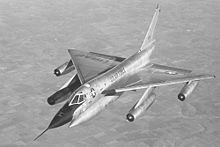
Picture - B-58A
The B-58 crews were elite, hand-picked from other strategic bomber squadrons. Due to some characteristics of delta-winged aircraft, new pilots used the F-102 Delta Dagger as a conversion trainer, before moving to the TB-58A trainer. The B-58 was difficult to fly and its three-man crews were constantly busy, but its performance was exceptional. A lightly loaded Hustler would climb at nearly 46,000 ft/min (235 m/s).
It had a much smaller weapons load and more limited range than the B-52 Stratofortress. The B-58 had been extremely expensive to acquire (in 1959 it was reported that each B-58A cost more than its weight in gold). Through FY 1961, the total cost of the B-58 program was $3 billion. It was a complex aircraft that required considerable maintenance, much of which required specialized equipment and ground personnel. The B-58 cost three times as much to operate as the B-52. This included special maintenance issues with the nose landing gear that retracted in a complicated fashion to avoid the center payload. It had an unfavorably high accident rate: 26 B-58 aircraft were lost in accidents, 22.4% of total production. It was very difficult to safely recover from the loss of an engine at supersonic cruise due to differential thrust. SAC had been dubious about the type from the beginning, although its crews eventually became enthusiastic about the aircraft; its performance and design were appreciated, although it was never easy to fly.
Two SAC bomb wings operated the B-58 during its operational service: the 43d Bombardment Wing, based at Carswell AFB, Texas from 1960 to 1964, and Little Rock AFB, Arkansas from 1964 to 1970; and the 305th Bombardment Wing, based at Bunker Hill AFB (later Grissom AFB), Indiana from 1961 to 1970. The 305th also operated the B-58 combat crew training school (CCTS), the predecessor of USAF's current formal training units (FTUs).
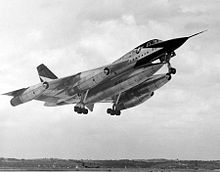
Picture - Takeoff
By the time the early problems had largely been resolved and SAC interest in the bomber had solidified, Secretary of Defense Robert McNamara decided that the B-58 was not going to be a viable weapon system. It was during the B-58's introduction that the surface-to-air missile (SAM) became a viable threat, especially the SA-2 Guideline, a SAM system the Soviet Union extensively deployed. The "solution" to this problem was to fly at low altitudes, minimizing the radar line-of-sight and minimizing exposure time.
Because of the denser air at low altitudes, the B-58 could not fly at supersonic speeds and its moderate range was reduced further, thereby negating the high performance the design paid so dearly for. In late 1965, McNamara ordered the B-58's retirement by 1970. Despite efforts of the Air Force to earn a reprieve, the phaseout proceeded on schedule. The last B-58s were retired in January 1970 and placed in storage in AMARC at Davis-Monthan AFB. The fleet survived until 1977, when nearly all remaining aircraft were sold to Southwestern Alloys for disposal. The B-58 as a weapons system was replaced by the FB-111A, designed for low-altitude attack, and less expensive to produce.
A total of 116 B-58s were produced: 30 trial aircraft and 86 production B-58A models. Most of the trial aircraft were later upgraded to operational standard. Eight were equipped as TB-58A training aircraft.
A number of B-58s were used for special trials, including testing the radar system intended for the Lockheed YF-12 interceptor. Several improved (and usually enlarged) variants, dubbed B-58B and B-58C by the manufacturer, were proposed but never built.
A popular culture reference connected to the B-58 is that singer John Denver's father, Colonel Henry J. Deutschendorf, Sr., USAF, held several speed records as a B-58 pilot.
Variants
XB-58: Prototype. Two built.
YB-58A: Pre-production aircraft, 11 built.
B-58A: Three-seat medium-range strategic bomber aircraft, 86 built.
TB-58A: Training aircraft, eight conversions from YB-58A.
NB-58A: This designation was given to a YB-58A, which was used for testing the J93 engine. The engine was originally intended for the XB-70 Valkyrie Mach 3 bomber.
RB-58A: Variant with ventral reconnaissance pod, 17 built.
B-58B: Unbuilt version. SAC planned to order 185 of these improved bombers; cancelled due to budgetary considerations.
B-58C: Unbuilt version. Enlarged version with more fuel and 32,500 lbf (145 kN) J58, the same engine used on the Lockheed SR-71. Design studies were conducted with two and four engine designs, the C model had an estimated top speed approaching Mach 3, a supersonic cruise capability of approximately Mach 2, and a service ceiling of about 70,000 ft ( m) along with the capability of carrying conventional bombs. Convair estimated maximum range at 5,200 nautical miles(6,000 mi;9,600 km). The B-58C was proposed as a lower cost alternative to the North American XB-70. As enemy defenses against high-speed, high-altitude penetration bombers improved, the value of the B-58C diminished and the program was cancelled in early 1961.
Operators
United States
United States Air Force
305th Bombardment Wing, Bunker Hill (later Grissom AFB), Indiana (1961-1970) 43d Bombardment Wing, Carswell AFB, Texas (1960-1964); Little Rock AFB, Arkansas, (1964-1970).
Survivors

Picture - B-58A Hustler AF Serial No. 59-2458, the "Cowtown Hustler", in front of the National Museum of the United States Air Force's restoration facility at Wright-Patterson AFB, OH
Today there are eight B-58 survivors:
TB-58A, AF Serial No. 55-0663, at the Grissom Air Museum, Grissom Air Reserve Base (former Bunker Hill AFB/former Grissom AFB), Peru, Indiana (Oldest Remaining Aircraft... fourth B-58 Built)
YB-58A, AF Serial No. 55-0665 at Edwards Air Force Base, California ("Snoopy")...this aircraft is abandoned on the Edwards AFB range and is in poor condition."B-58A Snoopy on Edwards AFB: Aerial imagery." virtualglobetrotting.com. Retrieved: 26 September 2010./ref;
YB-58A, AF Serial No. 55-0666 the Octave Chanute Aerospace Museum (former Chanute AFB), Rantoul, Illinois
TB-58A, AF Serial No. 55-0668 Lone Star Flight Museum, Galveston, Texas ("Wild Child II")
B-58A, AF serial No 59-2437 Lackland AFB/Kelly Field Annex (former Kelly Air Force Base), San Antonio, Texas ("Firefly II")
B-58A, AF Serial No. 59-2458 National Museum of the United States Air Force, Wright-Patterson Air Force Base, Dayton, Ohio ("Cowtown Hustler") This aircraft flew from Los Angeles to New York and back on 5 March 1962, setting three separate speed records, and earning the crew the Bendix Trophy and the Mackay Trophy for 1962. The aircraft was flown to the Museum on 1 March 1969. The aircraft is on display in the Museum's Cold War gallery.
B-58A, AF Serial No. 61-2059 Strategic Air and Space Museum, Ashland, Nebraska, ("Greased Lightning", which averaged 938 mph flying from Tokyo to London.)
B-58A, AF Serial No. 61-2080 Pima Air & Space Museum, Tucson, Arizona (Last B-58 to be delivered)
Specifications (B-58A)
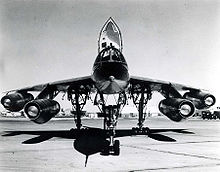
Picture - A front view of the B-58A in the "clean" configuration
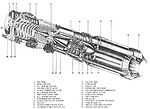
Picture - Cutaway diagram of the J79 with components labeled
Data from Quest for Performance
General characteristics
Crew: 3: pilot; observer (navigator, radar operator, bombardier); defense system operator (DSO; electronic countermeasures operator and pilot assistant).
Length: 96 ft 10 in (29.5 m)
Wingspan: 56 ft 9 in (17.3 m)
Height: 29 ft 11 in (8.9 m)
Wing area: 1,542 ft² (143.3 m²)
Airfoil: NACA 0003.46-64.069 root, NACA 0004.08-63 tip
Empty weight: 55,560 lb (25,200 kg)
Loaded weight: 67,871 lb (30,786 kg)
Max takeoff weight: 176,890 lb (80,240 kg)
Powerplant: 4x— General Electric J79-GE-5A turbojet
*Zero-lift drag coefficient: 0.0068
Drag area: 10.49 ft² (0.97 m²)
Aspect ratio: 2.09
Performance
Maximum speed: Mach 2.0 (1,319mph) at 40,000 ft (12,000 m)
Cruise speed: 610 mph (530 kn, 985 km/h)
Combat radius: 1,740 mi (1,510 nmi, 3,220 km)
Ferry range: 4,100 mi (4,700 nmi, 7,600 km)
Service ceiling: 63,400 ft (19,300 m)
Rate of climb: 17,400 ft/min (88 m/s) at gross weight
Wing loading: 44.0 lb/ft² (215 kg/m²)
Thrust/weight: 0.919 lbf/lb
Lift-to-drag ratio: 11.3 (without weapons/fuel pod)
Armament
Guns: 1x— 20 mm (0.79 in) T171 cannon
Bombs: 4x— B-43 or B61 nuclear bombs; maximum weapons load was 19,450 lb (8,820 kg)
Avionics
AN/APB-2 Bombing radar
AN/APN-110 Doppler navigational radar (part of Sperry AN/ASQ-42 Navigation & Bombing System)
AN/APN-170 Terrain-following radar
AN/APR-12 Radar warning receiver
Hughes Aircraft AN/APQ-69 podded side-looking aperture radar (mounted on RB-58A)
Goodyear AN/APS-73 podded synthetic aperture radar (mounted on RB-58A)
Notable appearances in media
Jimmy Stewart, a bomber pilot during World War II and the early cold war period, made a film for the Air Force, flying in the back seat of the B-58 on a typical low-altitude attack in the film Champion of Champions.
The B-58 has also appeared in the 1964 film Fail-Safe, where stock footage of B-58s was used to represent the fictional "Vindicator" bombers which attacked Moscow. Interestingly, the art used in the original magazine publication of the novel had depicted the "Vindicator" bombers as almost identical to B-58s but equipped with canards.
In Fail Safe, a 2000 made-for-TV remake starring George Clooney, the fictional Vindicator bomber was again represented by the B-58 Hustler.
Comparable aircraft
BAC TSR-2
Boeing XB-59
Dassault Mirage IV
Myasishchev M-50
North American A-5 Vigilante
Tupolev Tu-22 'Blinder'
Bibliography
Donald, David and Jon Lake, eds. Encyclopedia of World Military Aircraft. London: AIRtime Publishing, 1996. ISBN 1-880588-24-2.
Grant, R.G. and John R. Dailey. Flight: 100 Years of Aviation. Harlow, Essex: DK Adult, 2007. ISBN 978-0756619022.
Gunston, Bill. American Warplanes. New York: Crown Publishers Inc., 1986, p. 162. ISBN 0-517-61351-4.
Gunston, Bill. Bombers of the West. London: Ian Allan Ltd., 1973, pp. 185-213. ISBN 0-7110-0456-0.
Higham, Robin, Carol Williams and Abigail Siddall, eds. Flying Combat Aircraft of the USAAF-USAF (Vol. 1). Andrews AFB, Maryland: Air Force Historical Foundation, 1975. ISBN 0-8138-0325-X.
Miller, Jay. Convair B-58 Hustler (Aerograph 4). Midland, UK: Aerofax, 1985. ISBN 0-942548-26-4.
Miller, Jay. "History of the Hustler." Airpower, Vol. 6, No. 4, July 1976.
Swanborough, Gordon and Peter M. Bowers. United States Military Aircraft Since 1909. Washington, DC: Smithsonian, 1989. ISBN 0-87474-880-1.
United States Air Force Museum Guidebook. Wright-Patterson AFB, Ohio: Air Force Museum Foundation, 1975.
Wagner, Ray. American Combat Planes of the Twentieth Century. Reno, Nevada: Jack Bacon and Co., 2004. ISBN 0-930083-17-2.
Wilson, Stewart. Combat Aircraft since 1945. Fyshwick, ACT, Australia: Aerospace Publications Pty Ltd, 2000, p. 38. ISBN 1-875671-50-1.
Winchester, Jim, ed. "Convair B-58 Hustler." Military Aircraft of the Cold War (The Aviation Factfile). Rochester, Kent, UK: The Grange plc., 2006. ISBN 1-84013-929-7.
Living Warbirds: The best warbirds DVD series.
Source: WikiPedia